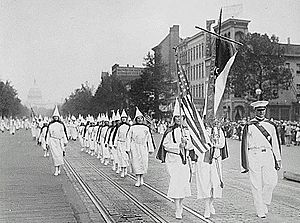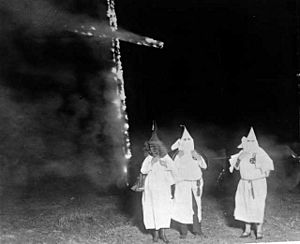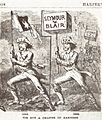Ku Klux Klan facts for kids
The Ku Klux Klan (often called the KKK) is a group that has spread hatred and used violence. It started in the southern United States on March 3, 1865. The KKK has mostly targeted African Americans. However, they have also attacked Catholics, Jewish people, and immigrants. The group wanted to keep "white power," meaning they believed white people should be in charge. They often used very violent acts, including killing people. The first Ku Klux Klan eventually broke up. But other groups with the same name and harmful ideas have been created since then.
The Ku Klux Klan (KKK) began in Pulaski, Tennessee, in 1865. This was right after the American Civil War ended. It first started as a social club for soldiers who had fought for the South (the Confederates). But the Klan quickly became a group that used fear and violence. Its main goal was to fight against the changes happening in the United States after the war. This time was known as the Reconstruction period.
Contents
What is the Ku Klux Klan?
The Ku Klux Klan is known as a hate group. This means they believe some groups of people are better than others. They often show strong dislike or hatred towards people based on their race, religion, or where they come from. The KKK has a long history of using violence to scare and hurt people they don't like.
How the KKK Started
After the American Civil War, the southern states were going through big changes. This period was called Reconstruction. It aimed to rebuild the country and give new rights to formerly enslaved African Americans. Many white Southerners did not like these changes. The KKK formed as a way to resist these new rights and keep white people in control. They wanted to stop African Americans from voting, owning land, or having equal rights.
What the KKK Believed and Did
The KKK believed in "white supremacy." This idea means they thought white people were superior to all other races. They used fear, threats, and violence to try and force their beliefs on others. Their actions included:
- Burning crosses, which was a symbol of their group.
- Attacking and sometimes killing African Americans.
- Targeting people who supported equal rights.
- Threatening and harming Catholics, Jewish people, and immigrants.
The KKK often wore white robes and hoods to hide their identities. This made it harder for people to know who they were.
Different Eras of the KKK
The Ku Klux Klan has existed in different forms over time.
- First Klan (1865-1870s): This was the original group formed after the Civil War. It was very active during Reconstruction. The government eventually passed laws to try and stop them.
- Second Klan (Early 1900s): This version of the KKK became popular again in the 1910s and 1920s. It grew partly because of a popular movie called The Birth of a Nation, which showed the KKK in a positive light. This group was against African Americans, immigrants, Catholics, and Jews.
- Later Klans (Mid-1900s to Present): After the 1920s, the KKK's power decreased. However, smaller groups using the KKK name have appeared at different times. They often become active during periods of social change, especially when civil rights for minorities are being discussed. These groups continue to promote hatred and sometimes use violence.
Even though the KKK's power has changed over the years, their message of hatred and their history of violence remain. Many people and organizations today work to fight against hate groups like the KKK.
Images for kids
-
KKK rally near Chicago in the 1920s
-
This Frank Bellew cartoon links the Democratic Party with secession and the Confederate cause.
-
Benjamin Franklin Butler wrote the Civil Rights Act of 1871.
-
Gov. William Holden of North Carolina
-
Movie poster for The Birth of a Nation, which has been widely credited with inspiring the 20th-century revival of the Ku Klux Klan.
-
In this 1926 cartoon, the Ku Klux Klan chases the Catholic Church, personified by St. Patrick, from the shores of America. Among the "snakes" are various supposed negative attributes of the Church, including superstition, the union of church and state, control of public schools, and intolerance.
See also
 In Spanish: Ku Klux Klan para niños
In Spanish: Ku Klux Klan para niños














